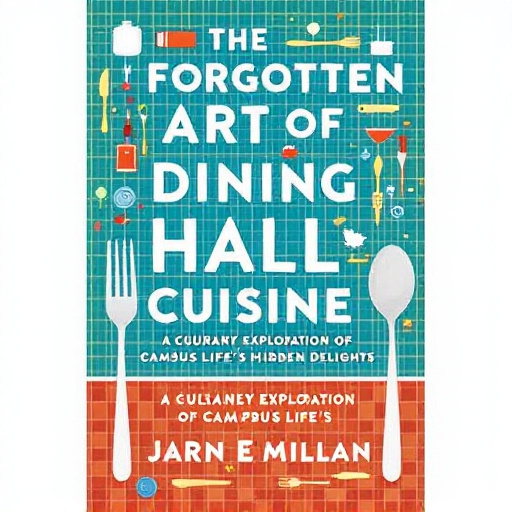Featured Articles
- "Chalk Art and Activism: How Campus Sidewalks Became a Canvas for Expression and Outrage"
- Quiet Quitting: The Unseen Impact of Minimalist Student Engagement on Campus Life Dynamics
- The Forgotten Art of Dining Hall Cuisine: A Culinary Exploration of Campus Life's Hidden Delights
- The Secret Life of Campus Pets: Uncovering the Furry Friends Behind Student Success Stories
- Top 6 Innovative Backpacks for Campus Life Revolutionizing Student Organization and Comfort Since 2019
The Forgotten Art of Dining Hall Cuisine: A Culinary Exploration of Campus Life's Hidden Delights
The Forgotten Art of Dining Hall Cuisine: A Culinary Exploration of Campus Life's Hidden Delights
In the whirlwind of campus life, the dining hall often fades into the background, overshadowed by the thrill of lectures and late-night study sessions. However, this often-overlooked hub boasts an array of hidden culinary delights that deserve a closer look.
Introduction: A Culinary Time Capsule
For many college students, the dining hall is a rite of passage. What’s found within its bustling walls offers a rich tapestry of flavors, memories, and sometimes, culinary mishaps. From traditional comfort food to eclectic international dishes, these spaces can serve as both a culinary classroom and a social hub.
The Evolution of Campus Cuisine
Dining hall cuisine has undergone a revolution in recent years. Once relegated to bland, overcooked meals, many campuses now offer a landscape of culinary diversity, recognizing that students are food-savvy and increasingly elaborate in their tastes. According to a study conducted by the National Restaurant Association, 79% of college students consider the quality of food a crucial factor when choosing where to enroll.
Let’s Get Personal: Stories from the Dining Hall
As a 24-year-old undergrad, I can attest to the power of shared meals. Take a moment to imagine a hurricane of scents wafting through the air: savory stews bubbling away, fresh bread crackling in the oven, and that distinctive aroma of roasted vegetables blessing the atmosphere. A table filled with friends, laughter echoing through the hall—there’s a magic in those moments. However, it was one fateful Tuesday that opened my eyes to the hidden charms: “Taco Tuesday.” That infamous day featured a smorgasbord of ingredients, from seasoned beef to zesty guacamole, and transformed a mundane week into an unforgettable fiesta. The flavorful tacos became synonymous with camaraderie, turning strangers into friends.
The Statistics Speak: Student Preferences
A survey conducted by the American College Health Association revealed that nearly 59% of students complain about the lack of variety in dining options. This statistic paint a vivid picture: while some campuses are flourishing with inspired menus, others still struggle with the remnants of outdated dining philosophies. A tale as old as time, right? Or maybe it’s just old cafeteria food.
Revising the Review: Modernizing Campus Dining
There’s a refreshing wave washing over campus dining. Many institutions have made a concerted effort to employ chefs trained in various cuisines, making meals not only tastier but also more authentic. Some colleges have even forged partnerships with local farms, contributing to the farm-to-table movement, which not only promotes sustainability but also supports local economies. A prime example is the University of California, Berkeley, which boasts a stellar dining program featuring organic ingredients and sustainable practices.
Unexpected Delights: Hidden Menus Within Dining Halls
Even as trends evolve, a delightful secret still lurks on dining hall menus. Did you know that many campuses have “hidden menus” with off-the-record specials? At the University of Massachusetts Amherst, students often request “The UMass Classic” – a secret recipe mac and cheese that’s so indulgent it’s become a cult favorite. When dining hall staff are approached with enthusiasm for customization, they often whip up unexpected wonders.
A Descriptive Journey: The Senses Experience
Embarking on a sensory tour of the dining hall can be a transformative experience. The hues of fresh greens and vibrant vegetables quickly captivate the eyes. The warm, fragrant waft of baking cookies bids you nearer like a siren's song. Imagine, for a moment, you are standing before an exquisite spread: golden-brown roasted chicken, delicate herbs adorning a fragrant quinoa salad, and steaming trays of spicy lentil stew. The possibilities are endless! Yet this visual feast is often eclipsed by the frenzy of student life.
Engaging Students: Cooking Participation
To further engage students, some campuses are incorporating cooking classes right within the dining hall. Such programs, like those at the University of North Texas, have allowed students to not only learn new culinary skills but also appreciate the art of cooking, elevating the dining hall experience into a hands-on culinary adventure. Cooking alongside peers fosters connections, transforming the dining environment into a nurturing community space.
The Reality Check: Not All Dining Halls Are Created Equal
However, the reality is that many dining halls still fall short of expectations. Factors like budget constraints and outdated facilities can hamper innovation. Culinary-minded students often express disappointment over limited hours or uninspired dishes. A 21-year-old biology major once shared how he braved a week-long meal plan on nothing but cereal after realizing he couldn't handle the “mystery meat” presented on Tuesday nights. These tales, while humorous, highlight the glaring inconsistencies in dining experiences across campuses.
Nostalgia and Comfort: The Dishes that Bring Us Home
For many, dining hall cuisine elicits nostalgia. A simple bowl of chili may remind one of cozy winter evenings, surrounded by family. Comfort food transcends age, background, and even geography—French fries and pizza remain universal favorites. For the 50-year-old alumni returning, the flavors of their college days serve as a culinary time capsule, throwing them back into simpler times, where the only worry was finals week and the freshness of Friday's pizza.
Campus Culture: More Than Meals
Dining halls aren’t just places to eat; they embody campus culture in vivid ways. They are watering holes for social interactions, venues for academic discussions, and sometimes the backdrop for spontaneous karaoke sessions. A meal shared can often break down barriers, fostering an inclusive atmosphere that celebrates diversity. At many campuses, the communal nature of dining creates a sense of belonging, especially for freshmen navigating the complexities of college life.
The Future of Dining Hall Cuisine
So what lies ahead for campus dining? Judging by trends, we can expect to see increased collaborations with local chefs, wider culinary diversity, and an embracing of dietary restrictions, including plant-based options. As colleges recognize the importance of mental health, the intersection of nutrition and wellness in dining hall cuisine is expected to become even more pronounced. The dining hall of the future is not just a place to grab food; it's a community hub focused on health and happiness.
Personal Reflections: An Invitation to Rediscover
Next time you step into your campus dining hall, take a moment to pause and rediscover it. Engage with staff, sample dishes you’ve never tried, and bring friends along for a shared experience. Whether it becomes a ritual or a one-off adventure, each meal could reveal flavors and friendships hidden in plain sight. As an 18-year-old freshman, I encourage you to embrace this culinary journey—who knows what delightful surprises await!
Conclusion: Embrace the Unexpected
The forgotten art of dining hall cuisine contains layers of hidden delights waiting to be explored. From the nostalgic flavors of comfort food to groundbreaking culinary innovations, these spaces hold potential deeper than a quick meal between classes. So, let’s celebrate the dining halls that, more than ever, contribute to the tapestry of our campus lives, forging connections through the universal language of food.




